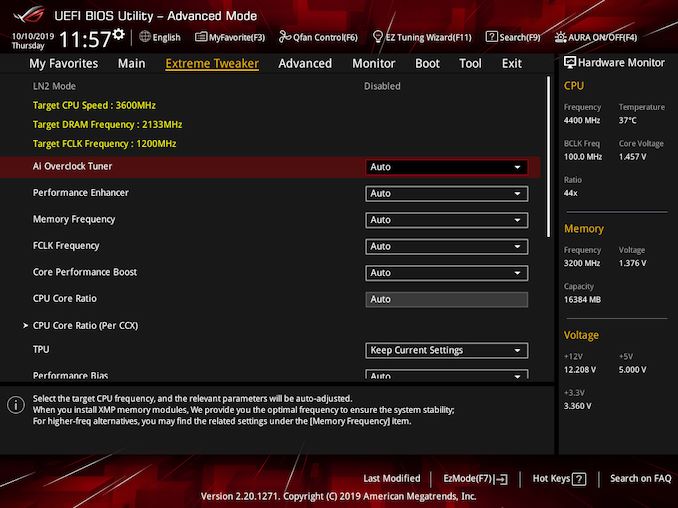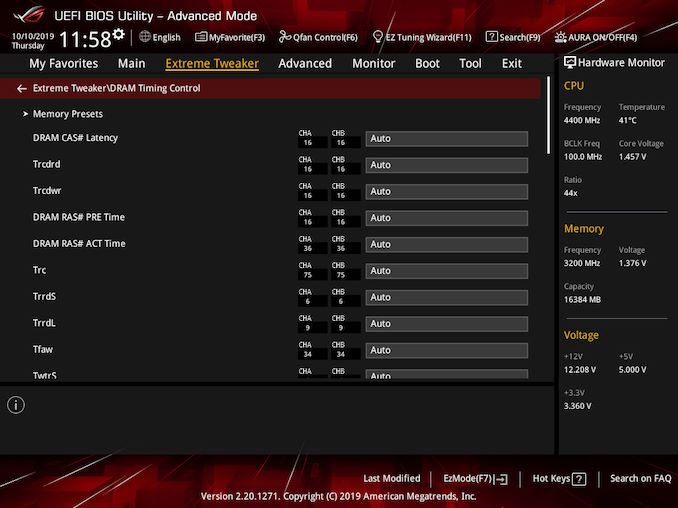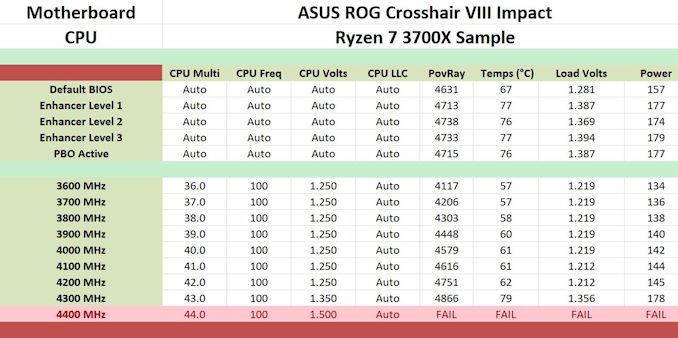The ASUS ROG Crosshair VIII Impact: A Sharp $430 Impulse on X570
by Gavin Bonshor on October 25, 2019 11:30 AM ESTOverclocking Ryzen 3000
Experience with the ASUS ROG Crosshair VIII Impact
Overclocking with the ASUS ROG firmware on the ROG Crosshair VIII Impact is quite pleasant as all of the overclocking related options are located in the Extreme Tweaker menu. For most users looking to overclock the Ryzen 3000 processors, the primary settings to change are the CPU Core Frequency, CPU VCore voltage; memory overclocking can be done automatically by enabling the X.M.P memory profile which ASUS calls D.O.C.P. To make fine-tuned adjustments, ASUS includes plenty of voltage and SoC options, although the ROG Crosshair VIII Impact doesn't support the integrated graphics of the Ryzen APUs as there are no video outputs on the rear panel.
There are no CPU overclocking presets to select from, but users can enable one of the memory presets which are a good starting point for high-binned memory; not only is this expensive but due to the locked Infinity Fabric clock-speed, it becomes less effective without making FCLK adjustments beyond using DDR4-3600 memory. Users can use the firmware fine-tune the primary, secondary, and tertiary memory latencies in the DRAM Timing Control section.
Users looking to make performance-enhancing changes will need to rely on manually overclocking the processors. This is something ASUS ROG is very competent at providing with a whole host of customizable frequency, voltage, and power-related settings for users to chomp on. The firmware on the ASUS ROG Crosshair VIII Impact is well equipped for overclocking, it's very responsive to use and works well. For the more extreme overclockers, there is plenty to appreciate with lots of scope for LN2 cooling with its overclocker's toolkit, an LN2 specific mode, and lots of extreme memory profiles to use as a starting point.
Overclocking Methodology
Our standard overclocking methodology is as follows. We select the automatic overclock options and test for stability with POV-Ray and OCCT to simulate high-end workloads. These stability tests aim to catch any immediate causes for memory or CPU errors.
For manual overclocks, based on the information gathered from the previous testing, starts off at a nominal voltage and CPU multiplier, and the multiplier is increased until the stability tests are failed. The CPU voltage is increased gradually until the stability tests are passed, and the process repeated until the motherboard reduces the multiplier automatically (due to safety protocol) or the CPU temperature reaches a stupidly high level (105ºC+). Our testbed is not in a case, which should push overclocks higher with fresher (cooler) air.
Overclocking Results
The ASUS ROG Crosshair VIII Impact is very efficient with its VDroop at all of the tested frequencies with the firmware set to the auto LLC setting. From 3.6 GHz to 4.2 GHz with 1.250 V set on the CPU VCore in the firmware, we experienced around 0.038 V of VDroop compensation. This not only reduces the overall power consumption at maximum load, but it also helps to reduce CPU temperatures. Moving up to 4.3 GHz at 1.350 V on the CPU VCore, we saw a slight increase to this value at load with a CPU VCore of 1.356 V. We know our Ryzen 7 3700X processor is capable of running 4.3 GHz with slightly less load VCore, but it seems the firmware was playing it safe with a focus on overclocking stability. Our POV-Ray benchmark performance was consistent as we went up in each 100 MHz frequency stepping. The limit on our Ryzen 7 3700X with our testbed cooler is 4.3 GHz, and the Impact couldn't get our chip stable at 4.4 GHz regardless of the voltage we applied.
When it comes to Precision Boost Overdrive performance, and unlike in our review of the GIGABYTE X570 Aorus Xtreme review, the ASUS ROG Crosshair VIII Impact default performance leads us to believe that at default settings, some element of PBO is applied. The performance at default settings in our testing is the equivalent of our testing at 4.1 GHz, which shows the CPU is boosting higher at default settings than some vendors models. We did expect to see some CPU overclocking presets on this model, but this is something ASUS may add at a later date, but it seems the best way to achieve maximum performance is to manually overclock the processor.













59 Comments
View All Comments
evernessince - Saturday, October 26, 2019 - link
It's the same people complaining on every article about the same issue, despite the fact that they've been told time and time again that these fans run at low RPM or off completely when you are not pushing the IO heavily. For most people, they are inaudible 100% of the time. These people want to spin their narrative, not try to understand what people are telling themHardwareDufus - Friday, October 25, 2019 - link
I won't say that I'm disappointed. I like Zen2.... but I will do just one more cycle of waiting.... I want to see the Zen3 successor to the Ryzen 9-3950X... and the RDNA 2 successor to the Radeon RX 5700 XT. That's all probably 12-15 months away, but that's just about right. I too am on an I7-3770k (longest lasting CPU I have ever had as well). This will be the last machine I build of my professional working career (If I've gotten 7+ years out of my I7-3770k, I'm sure I'll get 5 years out of the Zen3 16core CPU).hmmm, my trusty SilverStone SG055BB is mini-ITX / mini-DTX compatible (I own two of them). However, I'd pay a max of $300usd for a board like this (even though admittedly it's just about the perfect board... optical audio out, wifi and 2 M2 slots for storage... I ALWAYS have two harddrives).
We will see if a successor to this board is available in 12-15 months when I make the Ryzen Zen3 & Radeon RDNA-2 jump.
I'll be fine if only PCI4 is supported at that point.... I won't hold off for PCI5 to be implemented.
Will be interesting to see if we start seeing 4TB M.2 storage devices at that point as well... and if 32GB Dimms at good speed will be more affordable. Yeah.. Looking at 16 Cores @ 4Ghz+, 2X32GB for 64GB of Ram, 2X4TB for 8TB of storage to drive 2 32" 4K monitors. Will be a nice rig for the sunset years of my IT career...
alufan - Saturday, October 26, 2019 - link
honestly I do not understand folks who say this you have a CPU that is in modern terms slow and a system thats the same AMD comes along with a really disruptive product that is leagues ahead of what you have and in its third generation yet still you want to wait !What the heck exactly do they need to do to get your buy in, if AMD didnt exist or bring Zen to the party intel would happily keep chugging out its same CPUs for the next 10 years, support the company thats brought the fight to them!
HardwareDufus - Sunday, October 27, 2019 - link
Well, I will build the new system with cash on hand... So I may have misrepresented why I will sit out...... It's just that in my budget at end of 2020/2021 will make room for my computer. By then it will be Ryzen Zen 3 Radeon RDNA-2 and I will be curious to see what they offer... That's all. If their release is stalled significantly... then I 12 months from now I will buy current gen Ryzen Zen 2 Radeon RDNA....and would be equally delighted to do so...HardwareDufus - Sunday, October 27, 2019 - link
But perhaps in that time.... we will see a X570 variant that won't require a fan.... again, won't be a show stopper, as the CPU and Video cards will have fans aplenty anyway.....evernessince - Saturday, October 26, 2019 - link
And yet all X570 motherboards either turn off the fan during low load or run at low RPM, making then inaudible.PeachNCream - Sunday, October 27, 2019 - link
Noise isn't the concern. Fan failure is what bothers the OP as indicated by noting fans are a regression in the movement toward fewer moving parts (which can suffer from mechanical failure). While noise might be a concern, broken little fans that are a PIA to replace are what have peoples' panties in a twist right now and we haven't seen any X570 motherboards operating long enough to get a good understanding of whether or not fan failures are going to be a problem or if, as you implied, they are generally not running to begin with (which begs the question why the motherboard manufacturers are adding them in the first place instead of using a more effective passive heatsink).Oliseo - Sunday, October 27, 2019 - link
But you're not interested in anything but laptops, I don't get why you're arguing with people about something you no longer care about.Just like arguing I suppose.
RavenRampkin - Sunday, October 27, 2019 - link
May I kindly take Peach's initiative? xDNot interested in laptops. Have one, it's fine. The current pricing situation is meh. 6/12 ultrabook and 8/16 laptop parts are crazy expensive. Graphics are expensive (Turing), boring (Turing GTX) or both (Radeon, sadly. Power hogs or underperformers, or both). Zen is a skillful fighter for new users but nothing of particular interest over a good ol' 4700MQ (minus the Vega... got a dGPU anyway)...
As for the fans, sorry bud. If the interested customer has to find ways in which a hackjob (just sry, this IS a hackjob... it's not 2005 anymore) doesn't svck (oh the fans are low RPM, oh they're not that short-lived, oh there's passive mode at 0.1% load) and is actually *not that bad*, then it's not really a good hackjob. The need for this dayum fan in the first place screams a littley oopsie from ASMedia, or a design less efficient than usual on AMD's side. OK higher demands than for 300 and 400 series, then why does Shintel get away without le fans? (Pls correct if wrong.) Also, you can still do it passive, funnily enough. Why should it be a blessing and not a default option?
Case in point right above (or below?) me. Adaptation 100. Spare me some lube guys, been shilling for AyyMD, AsRock, Powercolor and Seasonic long enough :P want to try out some other companies
TL;DR there's no advantage nor purpose in reinventing the sleeve bearing (or dual ball, depends) wheel.
AshlayW - Monday, October 28, 2019 - link
PCI express 4.0 has significantly higher power requirements and thus heat output. X570 chipset is a repurposed Matisse IOD. Why you people complain about the chipset fan is beyond me, always gotta complain about something I guess. It's completely bloody inaudible on my X570M pro 4, and also completely unnecessary for all but the most intense I/o on both gen4 m.2 and the GPU.Stop complaining.